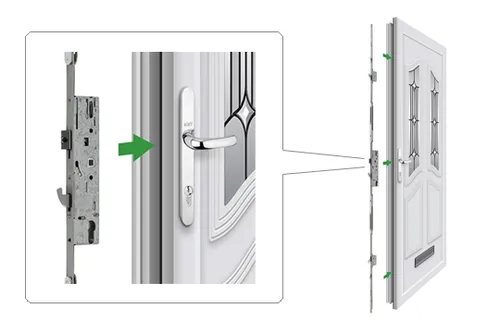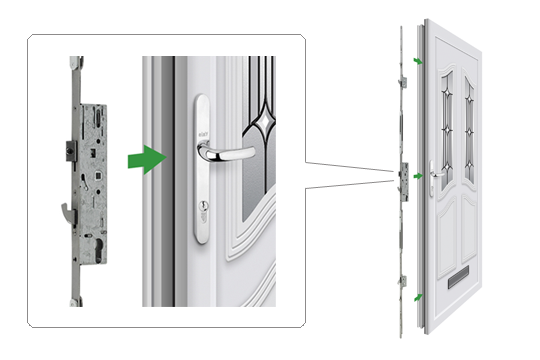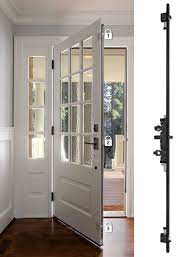How do you fix a locking mechanism on a uPVC door?

If you own a uPVC door, then you know how important the locking mechanism is to ensure the security of your home. Unfortunately, locks can wear out or break over time and need to be fixed.
Knowing how to properly identify and repair common issues with a locking mechanism on a uPVC door can save you time, money, and hassle in the long run.
This article will provide an overview of the anatomy of the locking mechanism used in uPVC doors, as well as the different types of locks used and how to select the right one for your door.
It also outlines step-by-step instructions on how to prepare for repair, identify potential causes, remove, and replace the lock, and troubleshoot any common problems. By following these tips and tricks, you can have peace of mind knowing that your home is safe and secure.
Overview of the Locking Mechanism

The locking mechanism used in uPVC doors is essential for keeping your home secure. It is important to understand the anatomy of a typical locking system, as well as the different types of locks used in uPVC doors and their advantages and disadvantages.
This article will provide an overview of these components so that you can make an informed decision when selecting the right lock for your door.
The typical anatomy of a locking system includes three major components: the latch, deadbolt, and strike plate.
The latch is a lever that engages when the door is closed, while the deadbolt slides into place to prevent it from being opened without a key.
The strike plate is secured to the frame and provides extra security by allowing the bolt to be inserted into a reinforced metal frame.
uPVC doors employ a variety of locks depending on individual preferences and budget constraints. Some common types include cylinder locks, mortise locks, night latches, rim locks, sash locks, padlocks, digital locks, and electromagnetic locks. Each type has its own advantages and disadvantages that should be considered before making a purchase decision.
Cylinder locks are among the most popular choices for uPVC doors due to their ease of installation and convenience. They offer keyless entry with an electronic code or fingerprint scanner but lack strength when compared with other options such as mortise or rim locks.
Mortise locks are more secure than cylinder locks but require more skill to install; they also take up more space within the doorframe which could reduce visibility from inside or outside your home.
Rim locks are simpler than mortise or cylinder models but provide less security since they only use one point of contact with the frame; however they are very easy to install if replacing an existing lock system.
Night latches are generally used on external doors because they automatically lock after closing; sash locks require manual operation since they use two points of contact with both sides of the doorframe for increased protection against forced entry attempts while padlocks offer highly visible deterrents against intruders but lack strength compared to other lock types mentioned previously-making them suitable only for low-risk security applications such as sheds or storage units rather than main entrance doorways.
Digital and electromagnetic models offer higher levels of security than mechanical models since access is restricted using either codes or magnetic cards respectively-however this comes at a cost premium which may not be feasible in certain cases such as rental properties where tenant turnover rates are high enough that regular replacement would become necessary over time due to wear-and-tear on these parts resulting from frequent usage over short periods by multiple users/tenants during their occupancy period(s).
When selecting a lock for your uPVC door it’s important to consider both cost and level of security required; typically higher-end models will offer greater protection but come at an increased price point whereas cheaper alternatives may save money but sacrifice some degree of safety depending on the model chosen so it’s best practice to read reviews prior committing financial resources towards any particular product purchase decision prior making commitment in order determine whether the investment made return value expected based upon individual needs/preferences before investing resources into any particular model/type given above outlined parameters recently discussed here within the current document being written/reviewed currently at present time (i.e., right now).
Preparing for Repair
Preparing for repairs is essential to protect the safety and security of your uPVC door. Before beginning any repair work, it is important to consult the manufacturer's manual for any instructions specific to your door.
This will help you understand how the locking system works and what steps need to be taken to properly replace or repair the lock.
Gathering the necessary tools and materials is also an important step in preparing for repair. Depending on the type of lock used, you may need various tools such as a screwdriver, drill, hammer, and replacement parts such as screws or bolts. Additionally, wear work gloves when handling any sharp edges that might be present to avoid injury.
To make sure that your uPVC door remains stable during the repair process, place a doorstop, block of wood, or other suitable object beneath it.
This will prevent it from moving while you are working on it. Finally, clean off any dirt and grime from the locking mechanism so that you can better see what is going on before starting repairs.
With these steps taken care of, you can begin to identify and repair any issues with your uPVC door's locking mechanism with ease and confidence.
Identifying the Issues and Potential Causes
Diagnosing the problem with a uPVC door’s locking mechanism is the first step in resolving any issues you may be having.
To do this, inspect the alignment of the door and strike plate, as well as any loose screws or bolts that may be present. Check for damage or wear and tear on the striker plate too. If you hear any unusual grinding, clicking, or other sounds then it could indicate an issue with your lock.
If all appears to be in order, then disassemble your lock by removing its mounting screws and faceplate from its frame.
After inspecting each pin and tumbler for damage, replace any worn components before reassembling the lock with high-quality replacement parts to provide maximum security when locked and unlocked repeatedly over time.
Removing and Replacing the Lock

Replacing a uPVC door lock can be a daunting task, but with the right preparation and know-how, it can be done with ease.
Before beginning, it is important to consult the manufacturer’s manual for any specific instructions regarding your lock as well as gather all of the necessary tools and materials beforehand.
To make sure safety while working, place a doorstop or block of wood beneath the door to keep it stable. After cleaning off any dirt or grime from the locking mechanism with a damp cloth, you are ready to begin.
Start by unscrewing the screws from either side of the door frame that secures the lock in place. Pay close attention to where each screw was located so they can be put back in their original positions during reassembly later.
Then inspect the lock for any signs of damage or wear and tear - replacing any broken parts or corrosion before continuing forward with reassembly.
Gently remove all components of the lock and set them aside in order while noting how they fit together as this will come into play when putting it back together again later on.
Once everything is disassembled, double-check for any other signs of damage, such as worn springs or old screws that may need replacing before attaching new components.
When reassembling your uPVC door lock, carefully follow your notes taken during disassembly and refer if needed, to diagrams found in your manual or online tutorials about locksmithing techniques specific to uPVC doors.
Once everything is connected correctly and tightly in place, test that your door still closes properly and locks securely with its new components installed correctly before moving on to final steps.
Finally, replace all the screws on either side of your doorframe - making sure they are firmly screwed into place - then give one last check just to make sure everything works correctly before completing this project!
Troubleshooting Common Problems
Diagnosing any issues with a uPVC door lock is essential to maintain its security. To troubleshoot any potential problems, begin by looking for dirt or debris that may be blocking the locking mechanism.
Then, make sure that the door is properly aligned in its frame and inspect the locking system for signs of wear or damage.
Additionally, confirm that the key is not worn down and check that each component inside the lock is working correctly before reassembling it according to the manufacturer's instructions provided in their manual guidebook.
Taking these steps can help guarantee a secure and functioning lock!
